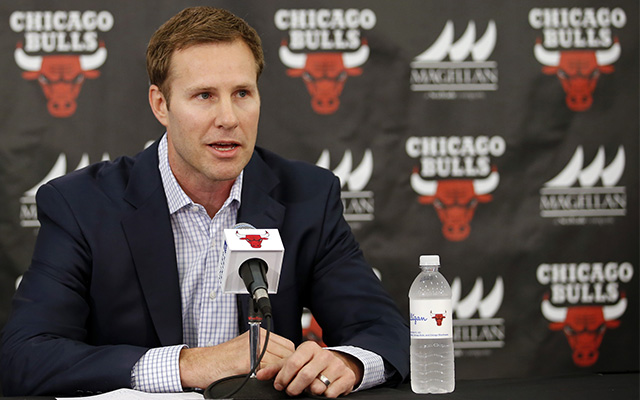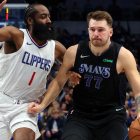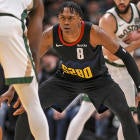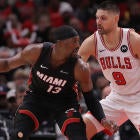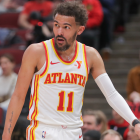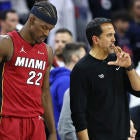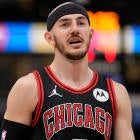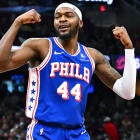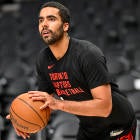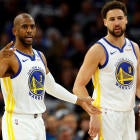The Bulls won 68 percent of their regular season games under Tom Thibodeau. They also made the playoffs in each of his five seasons, and won 50 or more games three times. That ain't bad. But Thibs never never got along with management and he notoriously drove his players not just into the ground, but beneath the soil and down to the very magma that pools beneath the earth's surface.
So he was fired.
In his place, the Bulls enter next season with Fred Hoiberg, who is fresh off a successful run at Iowa State. Hoiberg has extensive NBA experience -- four years in the Timberwolves' front office, 10 years as a player -- but the question still has to be asked: Can a first-year coach take a perpetual-playoff team that has consistently flirted with championship contention to the next level? Basically, can Hoiberg be Steve Kerr?
There are a number of surface-level areas where Hoiberg can likely act as a refreshing change in Chicago. Before you even get to the Xs and Os, he could simply stop playing Derrick Rose on back-to-backs, because he is a flaming disaster on them. He could also stand to get Jimmy Butler's minutes below the 38 per game he logged last year.
Beyond that, Hoiberg's imprint figures to be most recognizable on the offensive end. It's worth mentioning that the Bulls' defense, while stellar throughout Thibodeau's tenure, only registered as the 11th best defense in the league last year, but there doesn't seem to be as much room for growth on that end. On the other hand, there are some clear indications of what Hoiberg wants to do, and likely can do, with the Bulls' 11th-ranked offense, and those ideas fit very well with the modern NBA.
QUICK NOT FAST
There's a difference between playing fast and playing quick, and it's an important one. The 7 Seconds or Less Suns played fast, getting to the rim in transition constantly, always looking for fast-break opportunities. The old Don Nelson Warriors teams played fast, shot fast, scored a lot and lost a lot.
Playing quick, on the other hand, simply means getting into sets quickly. Instead of walking the ball up court, then dribbling off another ten seconds, it means getting into a set with a healthy amount of time (17 seconds or more) on the shot clock. You don't have to take the first shot that comes to you, but there is an emphasis on shooting earlier in the clock. If nothing is there, you have the time to patiently run through mutiple options. The Spurs are sneakily phenomenal at this. Tony Parker will zoom up the floor after a made basket and get the Spurs into a set early, which gives them more time to hunt down the right shot.
Last year, the Bulls were neither fast nor quick. Only 11.9 percent of their time on the floor was spent in transition, via Synergy Sports. It doesn't take advanced metrics to know that the Bulls pounded the air out of the ball consistently last season, and throughout Thibs' tenure, and that doing so left them with a lot of late-clock contested shots. Over 69 percent of their shots, in fact, came with 15 seconds or less on the shot clock.
In spite of all that, the Bulls were, as mentioned, 11th in offensive efficiency last season, as they were in 2011. So, basically, the two seasons when the Bulls had Derrick Rose healthy, they had the 11th best offense in the NBA. That's actually a tough mark to beat for a first-year coach, but speeding things up a bit should go a long way toward bumping up their efficiency. Incidentally, that's exactly what Hoiberg did at the college level with Iowa State.
Under Hoiberg, the Cyclones were well known as a team that ran quick action. The Bulls, by contrast, wound up with a shot with under four seconds on the shot clock 12 percent of the time last season, the 6th highest mark in the league. The Cyclones obviously had another 11 seconds on the clock, which skews this, but they wound up shooting with less than four seconds on the clock just 2 percent of the time, which was the third-lowest rate in Division 1. Watch this video from Pick and Pop and note that Hoiberg's guards aren't running off turnovers or misses and getting to the rim; his is mostly half-court play, it's just quick.
Watch this set outlined by YouTube user Half Court Hoops and envision Pau Gasol or Joakim Noah as the big coming up to the "pinch post" quickly.
Speaking of Gasol, he deserves a little more exposition. Gasol famously struggled and chafed with the Lakers under Mike D'Antoni, the ultimate fast-pace coach. Gasol was never comfortable with where D'Antoni got him the ball (despite the fact that using him as an elbow stretch-four is actually a really good idea given both his skills and his declining health as he gets older). With Hoiberg though, Gasol should be much more comfortable. There's a healthy amount of post-ups mixed in. The Cyclones got shots out of the post 11 percent of the time, the third-most of any set according to Synergy Sports.
Gasol may have to get up the floor a little bit more under Hoiberg, as will Noah. That could be problematic given the way both players' bodies have slowly been ground to dust under Thibs, but in terms of comfort, Hoiberg should make the most of their talents, both in post scoring and at the rim. Noah should thrive with the way Hoiberg values decision making and passing from his bigs.
Bulls blog Pippen Ain't Easy pointed out that Nikola Mirotic is another player set to have success with the kind of sets Hoiberg runs. BBall Breakdown did a fine job showing more ways that the Bulls' players specifically can thrive under Hoiberg here:
Around the 3:30 mark of that video, you'll see talk of Rose, who should feel right at home cutting around the screens of his bigs for backdoor lobs and bursts to the rim on handoffs. Meanwhile, Tony Snell and Doug McDermott will likely get better opportunities as well as Hoiberg is a 3-point apostle who has long embraced it as a path to success. With the NBA having gone 3-point-bonkers, now more than ever, Hoiberg's style couldn't be coming to Chicago at a better time.
So everyone's going to have success and everything's great. Wonderful, right? Except there are always players who don't succeed as much in new systems, nor do all players thrive in certain systems.
Jimmy Butler is one player that may not fit quite as well. Butler was given a lot of responsibility and control under Thibodeau to find opportunities in the pick and roll. With teams scheming for him more, and some slight changes under Hoiberg, he may have some adjustment issues. Taj Gibson's smaller height might not be ideal for some of the sets Hoiberg runs with the bigs, though his motor does fit the style.
Overall, though, there's every reason to think that what Hoiberg brings in an analytics-influenced, 3-point-barrage, quick-action style, should work in the NBA, and specifically with this Bulls team. He has smart, talented bigs, quick, explosive guards, and 3-point shooters like Mike Dunleavy and Snell. Bringing it together and getting the players to buy in after years of success under Thibs is a separate challenge, but on the floor, there's a good chance the Bulls take a step forward offensively next season.
Will this make them a contender? We'll dive into that in our offseason report on Wednesday. But one thing's for certain: A team that's had this kind of success, with this kind of starpower, that can maximize its offensive potential, is going to be a threat vs. every team in the East at the very least.
